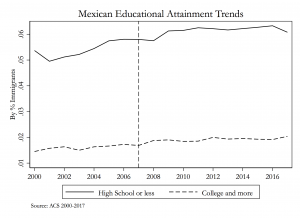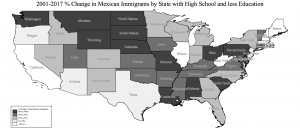Matthew Park ’20, Economics & Mathematics
Professor Sarah Pearlman, Economics Department
This summer I worked with Professor Pearlman on the topic of the impact of declining Mexican migration on US Labor markets, focusing on pre and post great Recession time frame.
Our first task was understanding the background of such a broad topic, conducting a literature review. We learned that fewer unskilled Mexicans were migrating due to Mexico’s economy on the rise and the US’s massive increase in border enforcement. Consequently, other immigrant groups were filling in the labor shortage, primarily those from Guatemala, Honduras, El Salvador.
We then began visualizing our findings using the US Census. Our findings confirmed our suspicions; more Mexican laborers were steadily leaving the agriculture and construction industries over the past two decades, being replaced by other immigrant groups. Additionally, we saw a clear trend in fewer Mexicans with high school education arriving, while more college educated Mexicans arriving to the US.
We also observed that Mexicans were migrating to atypical states such as Washington and the Plains states like Montana and Wyoming. They were leaving heavily Mexican populated areas including California and the border states and moving Northeast, contradicting total immigrant movement trends. This suggested that perhaps immigrant groups did not compete but rather would move elsewhere to seek jobs.
Lastly, we performed a diff and diff model regression, to observe the impact of an existing Mexican community and the year of the Great Recession 2007 on current immigrant communities in the same area. Interestingly, Asian and Central-American immigrants were most likely to settle where Mexicans were, while there was little correlation for South-Americans, West Indies, and other immigrant groups.
My experience with this project taught me that researching can begin with a single question, but end up answering and asking completely different questions later in the process. We may not have answered our original question, but obtained invaluable evidence about migration trends of various immigrant groups and their tendencies to follow certain industries.


